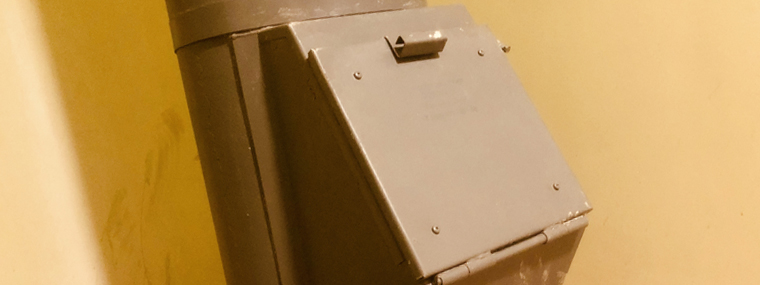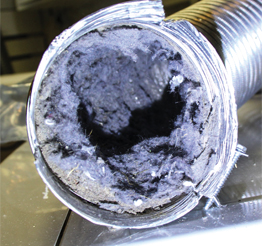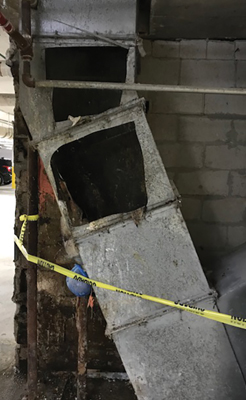
Trash Chutes and Dryer Risers
Unseen Fire Hazards In Your Building
By Joanna Ribner / Published January 2022

Most condominiums four floors and higher have a trash chute (or chutes) and a vertical dryer riser. These quiet workhorses do not get any love and attention until they stop working properly, and residents start complaining about odors, blockages, and damp clothes. But both systems should be on every board and CAM’s radars for routine maintenance and inspections; and the trash chute should be a line item in reserves as it does have a finite life, especially in Florida with the humidity and salty air.
The trash chute falls under the fire safety code and is inspected by the fire inspector annually. The inside of a trash chute is often coated with grease and debris, whether from trash bags that are leaking or torn or because residents sometimes dispose of unbagged items. Grease is, of course, highly flammable. Any fire in the chute can spread quickly. In the trash room at the bottom of the building, it is not uncommon for paint and other flammable materials to be stored. All it takes is for someone to toss a lit cigarette or candle down a trash chute, and there is the possibility of a deadly conflagration.
If a fire does break out in the trash room or in the chute itself, the chute acts like a voracious chimney in the middle of the building! The smoke and flames will be sucked up the chute and will escape onto the residential floors if the doors are not up to code.
The first safety feature that should kick in is the fire sprinkler system. The trash chute must be equipped with sprinkler heads on alternating floors and, of course, be connected to the main water supply. Your fire sprinkler contractor should be inspecting the sprinkler heads in the chute annually at minimum to ensure there are no leaks (which would corrode the chute) and to make sure the system is working.
If the fire originates in the trash room, the large fire damper door at the bottom of the trash chute—called either a guillotine or a discharge door—is designed to slide closed, sealing off the chute. Fire code requires that the door be equipped with a lead fusible link. Normally, the door will be in the open position so that garbage can fall into the dumpster. In the case of a fire, the link will melt, allowing the door to slide closed. Unfortunately, these links can fall off, especially when maintenance opens and closes the door to change out the dumpsters. Sometimes they get painted for whatever reason, and sometimes the link is fine, but the door itself is so rusted and bent a pack of mules would not be able to pull it closed! Quite a few cities and jurisdictions require a new link every year, with a date on it. The discharge door should be inspected and maintained at least once a year.
The next line of defense is the doors on the residential floors that the residents use to dispose of their trash. These doors must self-close, self-latch, and have a “B” Label UL rating of 1.5 hours. What this means is that the doors will withstand the fire for 90 minutes, allowing for safe evacuation of residents. Another safety feature of code-compliant doors is that the closer is hydraulic. It closes the door slowly, reducing the risk of a hand being caught in the door. The doors only open 45 degrees, which is intended to prevent a small child from climbing in the chute. It also should prevent residents from disposing of larger items, which can block or damage the chute.
It is important to note that if the doors need new parts, you should be purchasing UL-tested and rated parts. You can get a closer or a latch from a hardware store or on the internet for a much lower price than you can buy it from a trash chute contractor. But if you put a non-rated part in a rated door, you will void the rating, and the door will fail if there is a fire.
The challenge for board members and CAMs is in allocating money for repairs and maintenance to the trash chute. Probably 95 percent of your residents do not understand why the doors have to work a certain way, why a $30 closer is not the same as a $75 closer, and why the fire inspector is issuing citations! It is all about safety and should be as much of a priority as the fire alarm system.
The good news is that the chute is easy to maintain. Keeping it professionally cleaned will extend the life of the components as well as make a visit to the trash room a more pleasant experience if there are no odors and no roaches! Code violations can be found in an annual cleaning or inspection and dealt with before the fire marshal finds them. Major repairs usually occur if there is a serious blockage that must be cut out, or if something heavy is dropped down the chute, tearing the metal at the bottom. Rust is the biggest enemy. A leak in the chute or chemicals being poured down the chute (especially bleach) can cause a rust seam. Age is also a factor. Chutes over 25 years old are showing a lot of erosion.
Replacing a few floors of chute or an entire chute is an expensive undertaking and should be part of the reserve funding. Walls need to be removed and replaced. Sprinkler pipes may need to be moved or replaced. Permits need to be obtained. This is a project that needs to be planned and budgeted for. You do not want to ignore a problem until the chute collapses and has to be closed down.
Dryer risers are easier to maintain than trash chutes, but they probably generate 1000 percent more complaints! Residents are not happy when their clothes do not dry properly and are wrinkled and musty. The horizontal line from the dryer to the main vertical riser and the vertical riser itself all get coated in sticky, damp lint. When enough lint builds up, the dryer does not work efficiently and uses a lot more electricity. Lint is also extremely flammable, so avoiding a buildup is another safety measure that should be routine for your building.
The good news is that most risers only need to be cleaned every two to three years. In buildings with communal laundry rooms, it is an easy job to access each dryer, clean the horizontal vents on each floor, and then clean the vertical vent. It is a little more complicated in buildings where each unit has its own washer and dryer. In order to do the most efficient job, each unit must be entered, the dryer pulled away from the wall, and the horizontal line cleaned. It requires coordination between the manager, the resident, and the vendor. But the results are more efficient drying, reduced electricity usage, eliminating blow-back of hot air, and a safer building with the removal of lint.
Joanna Ribner
Owner, Southern Chute
Southern Chute Inc. started operations in September of 2001 and now has offices in Fort Lauderdale and Ft. Myers. We are state-licensed sheet metal contractors, specializing in replacement of chute systems in existing buildings. A family-owned business run by Joanna Ribner and her brother-in-law, Sandy Ribner, we are proud of the long tenure of our staff and the loyalty of our customers. For true excellence, call the industry leader and innovator! For more information on Southern Chute, call (866) 475-9191 or visit www.SouthernChute.com.






